From the February 2021 issue of Apollo. Preview and subscribe here.
What is the Bilderatlas Mnemosyne, this strange assembly of passionate postures, mute and motley on their numbered black panels? A pictorial history of European art; a map showing the pathways of its recurring figures; an instrument for research; an argument about the development of human culture; a catalogue of types; a collage or montage of emotion. Aby Warburg (1866–1929), the German-Jewish art historian whose last years were devoted to the project, described it more soberly, as ‘an attempt at an art-historical cultural science’, and provided an almost parodically formal description: ‘An Image Series for the Investigation of the Function of Pre-formed Ancient Expressive Values in the Representation of Animated Life in European Renaissance Art’. But these academic claims coexisted with richer, stranger articulations. He named his atlas of images for Mnemosyne, the mother of the muses and the patron of memory, suggesting that it was both a matrix for creativity, and a theatre of remembrance and the return of the repressed. In the critical industry that has grown up around it, the Bilderatlas has been described as a ‘kinetic grotto’, a device for divination, a machine for metaphor, an exposure of the archetypes of the psyche, and an externalisation of the paranoiac workings of Warburg’s own mind.
In practical terms, the Bilderatlas, in the form it had reached at Warburg’s death in 1929, consists of 63 vertical panels, 150 x 125cm, covered in black hessian, on which Warburg, with the help of collaborators, assembled 971 items: reproductions of paintings and works of art, pages from manuscript and printed books, newspaper articles, photographs. The subjects ranged from Babylonian stelae and divinatory tablets to stamps, news reports on the Zeppelin, and contemporary adverts for the Hamburg fishing industry, though the bulk of the material shows mythological figures in Greek, Roman and Renaissance art. The panels were erected in the reading room of the research institution that Warburg had founded in Hamburg, the Kulturwissenschaftliche Bibliothek Warburg, as working materials towards a book project. This would give a verbal account of what the panels illustrated – an argument about the Renaissance revivification of what Warburg called pathos formulae (Pathosformeln). These nexuses of posture, gesture, and expression, Warburg speculated, imprinted the high emotion and propitiatory actions of ancient ritual, and were transmitted both through an art-historical tradition of imitation, and an atavistic identification with the emotions expressed and their freight of pity and fear, with an afterlife persisting to the present.
The book was never written. What we have instead is what Warburg called a Denkinstrument, a tool to think with: not the work itself, but the condition for its emergence. The photographs taken of the Bilderatlas panels in 1929 show the images affixed by clips, easily detachable, and so liable to movement. Warburg continually revised the classification system of his library, and compulsively reordered his numerous boxes of index cards. Shelves, boxes, and panels were all cognitive contraptions, holding places for temporary configurations of books, cards, images. They used adjacency – what Warburg called ‘good neighbourliness’ (gute Nachbarschaft) – and spatial disposition to prompt unexpected relations and trajectories of thought. Despite the local patterns of cohesion in individual panels, and their correspondence with arguments Warburg made in lectures and essays, their value as thought-instruments rests not in their illustration of a particular case, but in their provisionality, testifying to the always imminent possibility of reorganisation. Other constellations are possible.
This has at once given the Bilderatlas a tremendous enigmatic charge, inviting scholarly labour and imaginative reconstruction, and thwarted all attempts to complete it. After Warburg’s death, Ernst Gombrich was tasked with rendering the Bilderatlas publishable; he gave up. Gertrud Bing, Warburg’s assistant who collaborated with him on the arrangement of 1929 and the elliptical panel headings, continued to elaborate the themes of the work into the 1940s, alongside Fritz Saxl and Edgar Wind, but no final version was realised. The panels were dismantled and the reproductions subsumed into the photographic archive at the Warburg Institute, which emigrated, with the library and several of Warburg’s collaborators, to London in 1933. Subsequent editions and exhibitions, including the 2000 edition by Martin Warnke and Claudia Brink for Warburg’s Collected Works (De Gruyter), use reproductions of the black-and-white photographs of the panels to render the Bilderatlas in its state of incompletion, foregrounding its invitation to use it as a means of thought.
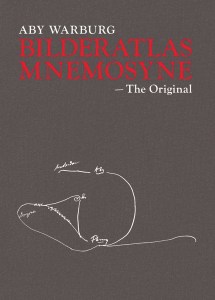 This openness and irresolution is also the tack taken by this wonderful new facsimile, which accompanies an exhibition that took place at the Haus der Kulturen der Welt (HKW), Berlin, last autumn (it travels to the Bundeskunsthalle, Bonn, this month), and a wider project on the part of the Warburg Institute to digitise and make available its archival materials, including a virtual tour of the recent display (accessible at www.warburg.sas.ac.uk). Collectively, they advance both the accessibility of, and the possibilities of thought offered by, the Bilderatlas. This is the first reconstruction of the Bilderatlas to use not the 1929 photographs of the panels, but, as far as possible, to reconvene the photographs, prints, and reproductions that Warburg himself assembled. The book and exhibition demonstrate an astonishing labour of reconstruction by the curators, Roberto Ohrt and Axel Heil, through which much can be learned about Warburg’s methods in acquiring reproductions, of the construction of the panels, and of the ways in which images could serve multiple purposes. The provision in the book of images of earlier versions, a concordance, and an index, also allow the reader to navigate the panels by artist or by mythological figure. The excellent prefatory essays by the Warburg’s director, Bill Sherman, by Bernd Scherer, director of the HKW, by the curators, and by the Warburg’s archivist, Claudia Wedepohl, supply ample information about the evolution, material form, and afterlife of the Bilderatlas, but they are not a guide to use. In the absence of Warburg’s own commentary on the panels – and before the publication of a companion volume of detailed commentary, due in 2021 – the reader is left to their own devices in deploying this thought-instrument. This initially induces a sense of bewilderment in a blizzard of images, especially those panels that show several populous crowd scenes or triumphal processions: we do not know where to look. But the corresponding effect is to leave the viewer or reader free to establish their own pathways, in a practice of what Georges Didi-Huberman has called an ‘ordered disorientation’.
This openness and irresolution is also the tack taken by this wonderful new facsimile, which accompanies an exhibition that took place at the Haus der Kulturen der Welt (HKW), Berlin, last autumn (it travels to the Bundeskunsthalle, Bonn, this month), and a wider project on the part of the Warburg Institute to digitise and make available its archival materials, including a virtual tour of the recent display (accessible at www.warburg.sas.ac.uk). Collectively, they advance both the accessibility of, and the possibilities of thought offered by, the Bilderatlas. This is the first reconstruction of the Bilderatlas to use not the 1929 photographs of the panels, but, as far as possible, to reconvene the photographs, prints, and reproductions that Warburg himself assembled. The book and exhibition demonstrate an astonishing labour of reconstruction by the curators, Roberto Ohrt and Axel Heil, through which much can be learned about Warburg’s methods in acquiring reproductions, of the construction of the panels, and of the ways in which images could serve multiple purposes. The provision in the book of images of earlier versions, a concordance, and an index, also allow the reader to navigate the panels by artist or by mythological figure. The excellent prefatory essays by the Warburg’s director, Bill Sherman, by Bernd Scherer, director of the HKW, by the curators, and by the Warburg’s archivist, Claudia Wedepohl, supply ample information about the evolution, material form, and afterlife of the Bilderatlas, but they are not a guide to use. In the absence of Warburg’s own commentary on the panels – and before the publication of a companion volume of detailed commentary, due in 2021 – the reader is left to their own devices in deploying this thought-instrument. This initially induces a sense of bewilderment in a blizzard of images, especially those panels that show several populous crowd scenes or triumphal processions: we do not know where to look. But the corresponding effect is to leave the viewer or reader free to establish their own pathways, in a practice of what Georges Didi-Huberman has called an ‘ordered disorientation’.
The facsimile’s title, which claims to present the ‘original’ Bilderatlas, serves to draw more emphatic attention to the fact that it is assembled of reproductions. (The facsimile, accordingly, is a reproduction of reproductions, though not, like previous editions, a reproduction of reproductions of reproductions.) Walter Benjamin, who was influenced by Warburg, claimed in a famous essay of 1935, ‘The Work of Art in the Age of Mechanical Reproducibility’, that reproductions eliminate the original’s ‘aura’ and authenticity, the ‘quality of its presence’, and excerpt it from tradition. Though tradition and historical context are important in the Bilderatlas, there is a deliberate anti-aura in Warburg’s images. This is the first time the panels have been printed in colour, but this doesn’t make for a sudden technicolour blaze after the monochrome photographs of 1929: the majority of the images are still in tones of grey, brown, black, and white. Warburg’s own gnomic introduction to the project suggests that the making of art encourages the beholder to ‘gaze in cultic devotion at the idol that has been created’. The images on the panels are not intended to evoke that devotion, however, but to invite speculation on its causes. The eye doesn’t rest in awe on the individual work, but travels between images in comparison and contrast.
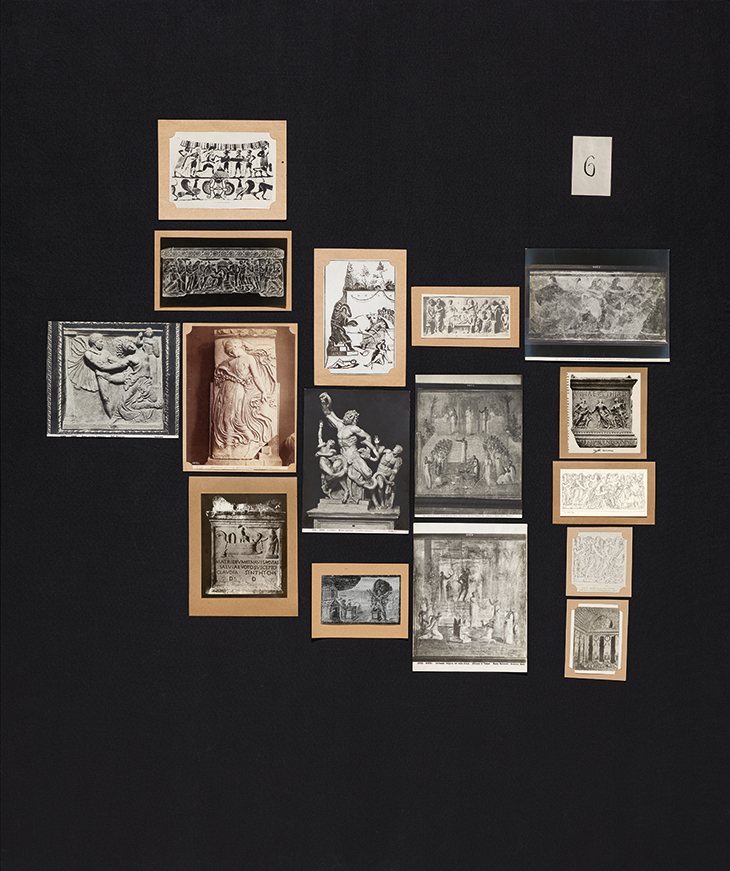
Panel 6 of Aby Warburg’s Bilderatlas Mnemosyne (reconstruction of 2020). Photo: Wootton/fluid
This desacralisation is particularly vivid in the Bilderatlas’s treatment of totemic images like the ancient statue of Laocoön and His Sons. Its rediscovery in 1506 fundamentally changed the expression of emotion and representation of musculature in Renaissance sculpture. Discussions of it in the writings of Lessing and Winckelmann were foundational for German aesthetics. Warburg placed a photograph of the statue on Panel 6, as part of a sequence of classical precedents. The statue is central, and, as if in acknowledgement of its decisive influence, the other images are arranged in a formation that echoes its composition. When the death of Laocoön recurs as a motif on Panel 41a, however, it is shown 19 times, 13 of them post-1506, in paintings, drawings, prints, bronzes, and manuscript illustrations. The statue, imitated in some but not all of the iterations, is demoted from exemplary status as the paradigm of artistic expression or the emotive beauty of ancient sculpture, to a single instantiation among many of a Pathosformel.
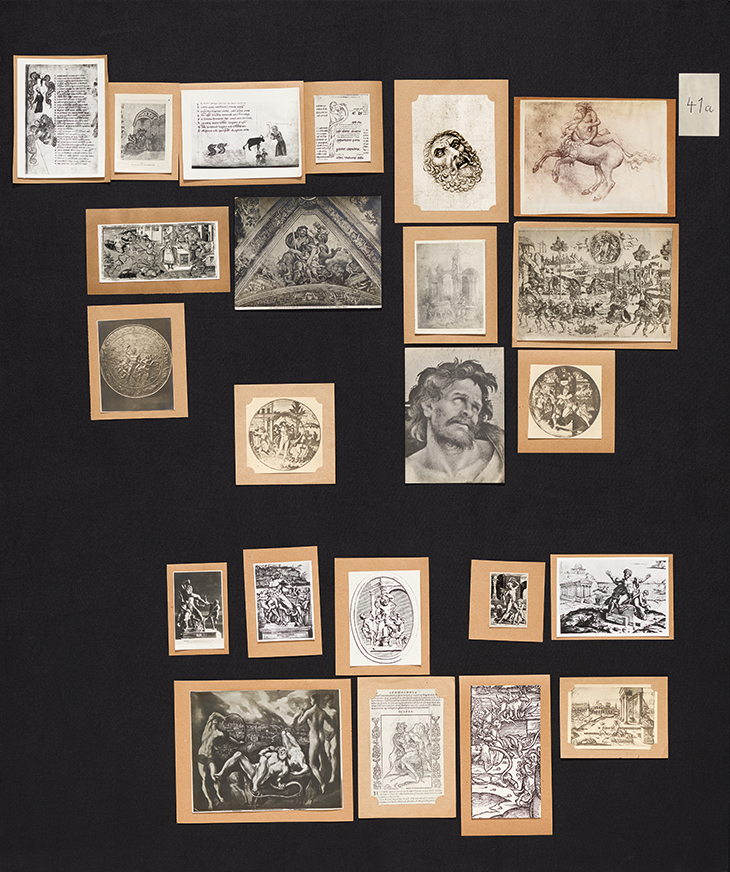
Panel 41a of Aby Warburg’s Bilderatlas Mnemosyne (reconstruction of 2020). Photo: Wootton/fluid
The difference is only made starker by a sibling exhibition that was held at the Gemäldegalerie, a short walk away in Berlin, of some of the originals of the images reproduced in the Bilderatlas. To move between the two exhibitions – as the virtual tours still allow us to do – is to move between two ways of thinking and feeling with images. It is a tellingly different experience to encounter Ghirlandaio’s Judith with her Maidservant, glowing sumptuously and singularly on the black wall of the Gemäldegalerie (or in vivid pixilation on a screen), and to pick out the same painting in monochrome, twice, at postcard size and slightly above floor-height on Panel 47, alongside 26 other iconographically similar images. Painterly technique and the viewer’s pleasure recede, and compositional elements prevail. Judith’s maid is an example of the figure of the ‘head-bearer’ to which half of Panel 47 is devoted, but also reiterates the incongruous nymph entering from the right in Ghirlandaio’s Birth of John the Baptist, a key image for Warburg, which dominates Panel 46. Judith, with her sword raised to decapitate Holofernes in some of the other images on Panel 47, anticipates a modern photograph on Panel 77 of a woman playing golf, the club at the peak of the swing; the golf-player, meanwhile, also points back to the images of Fortune and Occasion on Panel 48, the curve of her stance imitating the bellying of the sail with which Fortuna harnesses the wind.
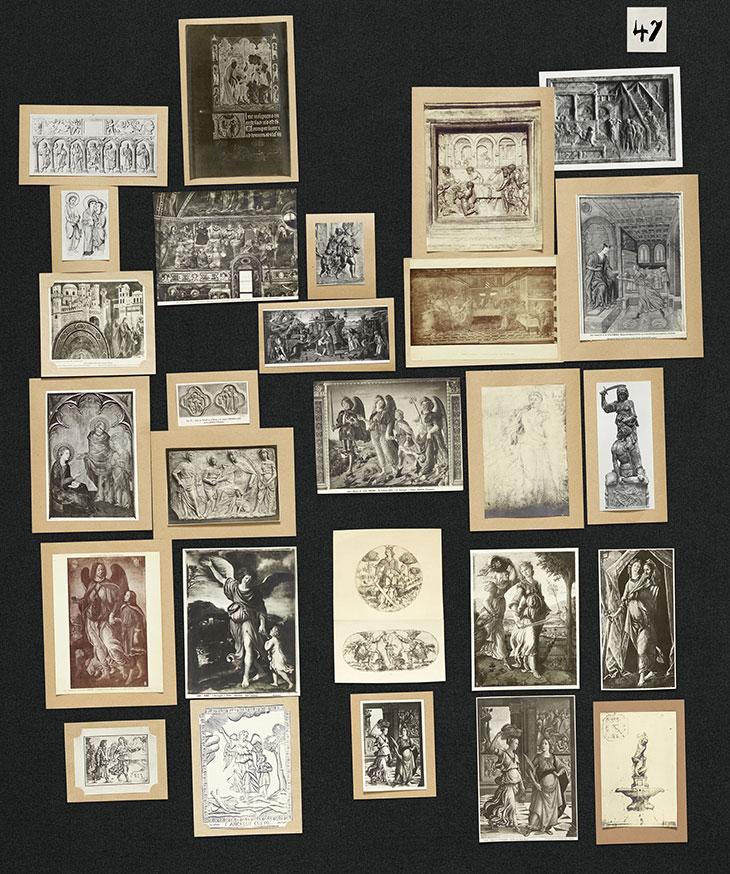
Panel 47 of Aby Warburg’s Bilderatlas Mnemosyne (reconstruction of 2020). Photo: Wootton/fluid
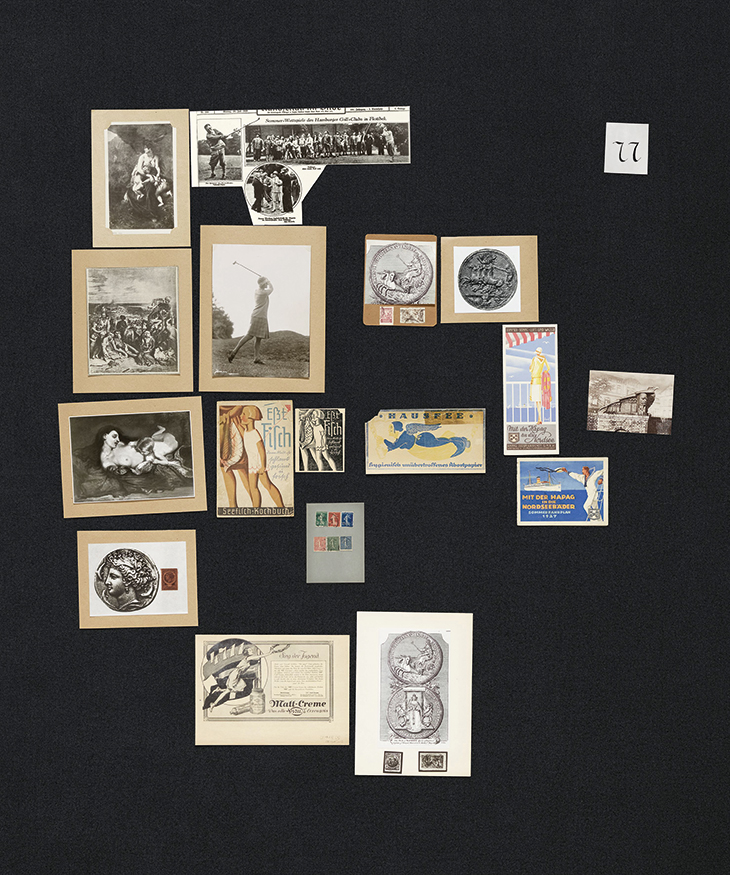
Panel 77 of Aby Warburg’s Bilderatlas Mnemosyne (reconstruction of 2020) Photo: Wootton/fluid
All of this flitting from image to image, from panel to panel, makes thinking a practice of motion. Like Warburg’s rearrangements of books, or index cards, navigating the panels of the Bilderatlas is an exercise in embodied thought. It is a frustration, then – and no doubt more so for the curators – that only a fraction of the potential audience could experience moving through the exhibition in Berlin, thwarted by the restrictions on travel imposed by the pandemic and the early closing of the run. Nonetheless, the facsimile makes itself felt as a tool for thought that involves the reader physically, not least because the book is huge, measuring 60 x 44cm and weighing almost six kilograms. And the project is also, after all, an atlas: a way of both representing distance and making it compassable. Panel A, the first, shows ways of mapping the heavens, Europe, and genealogies on single sheets of paper. The panels induce impossible geographical and temporal proximities. The use of reproductions is itself a way of collapsing distance, appropriating things from their context into new relations.
A consciousness of distance is, in fact, the point of the Bilderatlas. The first sentence of Warburg’s introduction, edited here for the first time in its final form by Claudia Wedepohl, asserts that ‘[o]ne could describe a conscious distancing between the self and the environment as the founding act of human civilisation’ (my translation). That conscious distance establishes what Warburg called Denkraum: thought-space, room for thinking. The shift from cultic devotion to critical thought, in the move from original artworks to the mobile reproductions on Warburg’s panels, is a shift into that space. The assembly of the multiple images in the Bilderatlas allows attention not just to the images themselves, but also, as Warburg emphasised, to the gaps (Zwischenräume) between them, in which thought happens.
It is thus an irony that Warburg, at the end of a famous lecture on Hopi snake rituals delivered in 1923, turned abruptly from discussion of the cosmic, astrological, and religious significance of snakes (including in the Laocoön myth), to complain about Thomas Edison’s ‘copper snakes’, the telegraph wires which had begun to reticulate America. The apparently miraculous achievements of technology – communication at a distance, the collapse of time and space which makes it possible to speak to someone on the other side of the world – seemed to Warburg calamitous. In his hyperbolic terms, electrical ‘Augenblicksverknüpfung’, or instantaneous connection, murders both the spaces of cultic devotion and the Denkraum that succeeds them: ‘the telegram and the telephone destroy the cosmos’ by collapsing the hard-won distance of thought. But the virtual tours of the Berlin exhibitions make the most of the possibilities of Augenblicksverknüpfung to enable the experience of operating in thought-space, in the absence of the possibility of actual movement in the world. Instantaneous connection, as our contemporary crisis has made us all too aware, is both a bane and a boon, a way of making things proximate and of remembering how far away they actually are.
Bilderatlas Mnemosyne – The Original by Aby Warburg; Axel Heil and Roberto Ohrt (eds.) is published by Hatje Cantz.
From the February 2021 issue of Apollo. Preview and subscribe here.
Unlimited access from just $16 every 3 months
Subscribe to get unlimited and exclusive access to the top art stories, interviews and exhibition reviews.

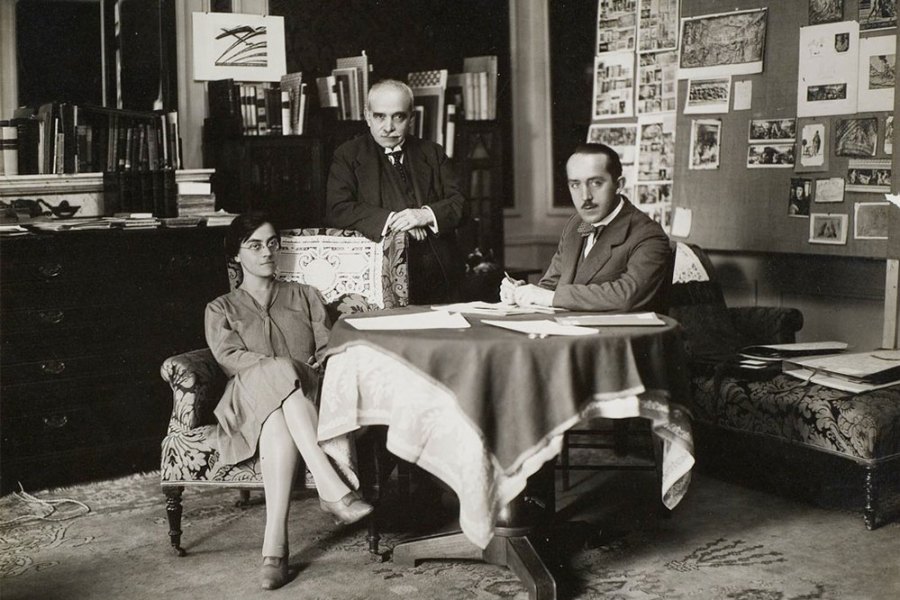
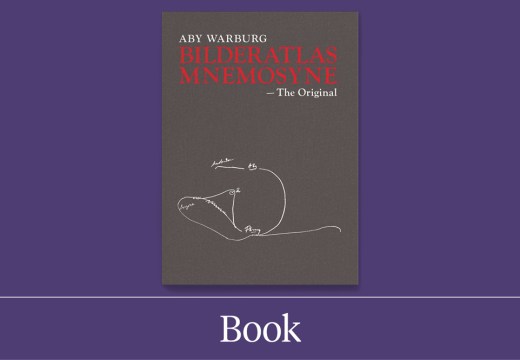
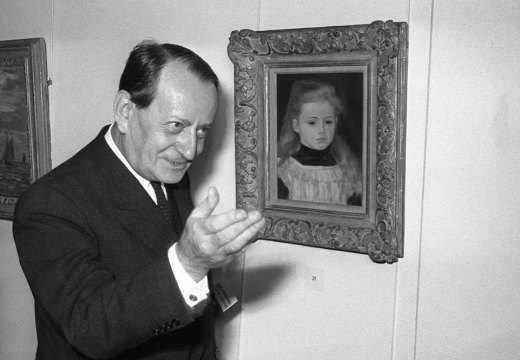
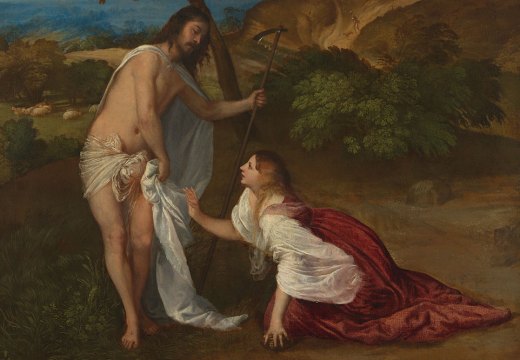









![Masterpiece [Re]discovery 2022. Photo: Ben Fisher Photography, courtesy of Masterpiece London](http://www.apollo-magazine.com/wp-content/uploads/2022/07/MPL2022_4263.jpg)
It’s time for the government of London to return to its rightful home